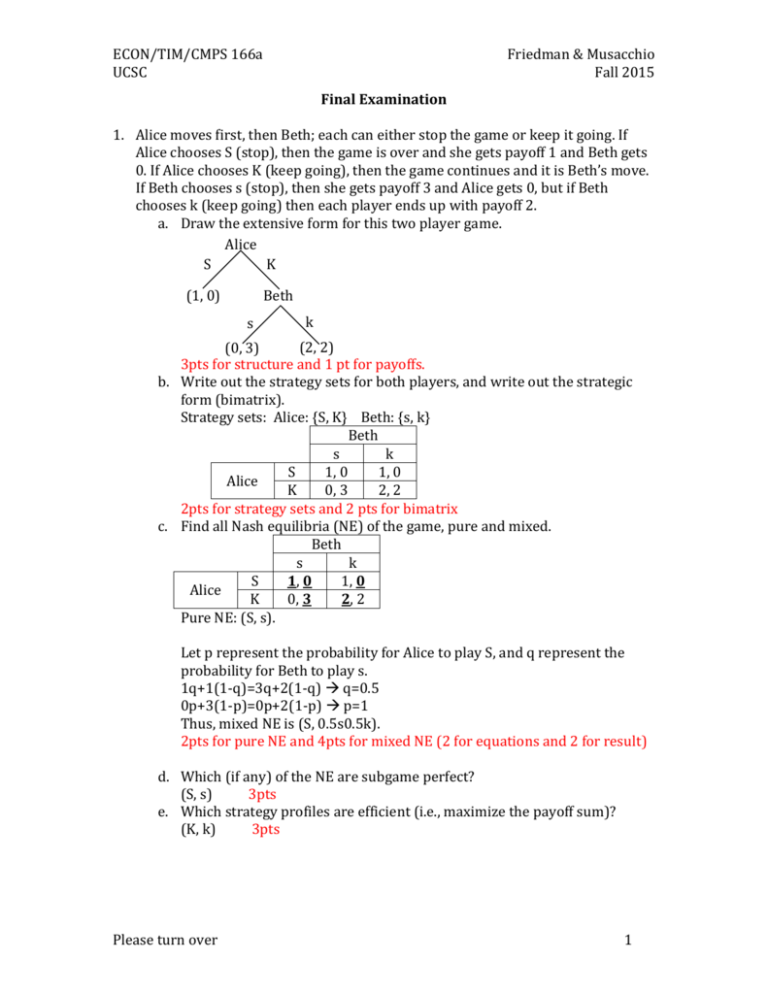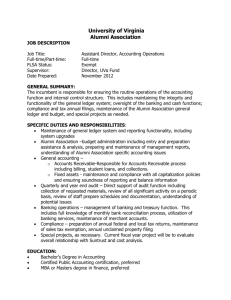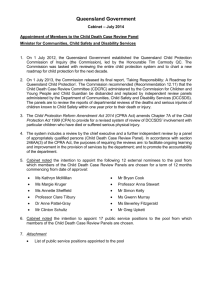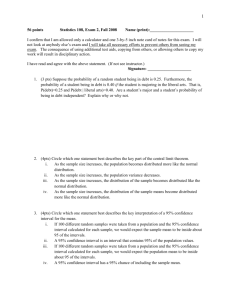posted
advertisement

ECON/TIM/CMPS 166a
UCSC
Friedman & Musacchio
Fall 2015
Final Examination
1. Alice moves first, then Beth; each can either stop the game or keep it going. If
Alice chooses S (stop), then the game is over and she gets payoff 1 and Beth gets
0. If Alice chooses K (keep going), then the game continues and it is Beth’s move.
If Beth chooses s (stop), then she gets payoff 3 and Alice gets 0, but if Beth
chooses k (keep going) then each player ends up with payoff 2.
a. Draw the extensive form for this two player game.
Alice
S
K
(1, 0)
Beth
s
k
(2, 2)
(0, 3)
3pts for structure and 1 pt for payoffs.
b. Write out the strategy sets for both players, and write out the strategic
form (bimatrix).
Strategy sets: Alice: {S, K} Beth: {s, k}
Beth
s
k
S
1, 0
1, 0
Alice
K
0, 3
2, 2
2pts for strategy sets and 2 pts for bimatrix
c. Find all Nash equilibria (NE) of the game, pure and mixed.
Beth
s
k
S
1, 0
1, 0
Alice
K
0, 3
2, 2
Pure NE: (S, s).
Let p represent the probability for Alice to play S, and q represent the
probability for Beth to play s.
1q+1(1-q)=3q+2(1-q) q=0.5
0p+3(1-p)=0p+2(1-p) p=1
Thus, mixed NE is (S, 0.5s0.5k).
2pts for pure NE and 4pts for mixed NE (2 for equations and 2 for result)
d. Which (if any) of the NE are subgame perfect?
(S, s)
3pts
e. Which strategy profiles are efficient (i.e., maximize the payoff sum)?
(K, k)
3pts
Please turn over
1
ECON/TIM/CMPS 166a
UCSC
Friedman & Musacchio
Fall 2015
2. Suppose that two player game just described is repeated indefinitely, and each
player’s payoffs in that repeated game is the discounted sum of the stage game
payoffs; the discount factor d is somewhere between 0 and 1.
a. What aspects of the repeated game tend to make the discount factor d
closer to 1?
(1) Higher survival probability to the next period, and
(2) Lower interest rate/ present preference
2pts for each reasoning. 3pts max.
b. Describe a strategy profile for the repeated game that might promote
efficiency.
Example: grim trigger strategy: Initially, both of them play K/k in every
round. If someone is playing S/s, then the other will play s/S forever. TFT
or other reasonable strategy is acceptable.
4pts. Must specify the complete strategy (initial and continuing with
cooperative or non-cooperative). Otherwise, you get 2
c. Suppose that d=0.6. Show whether your strategy profile can indeed
support efficient play as a NE of the repeated game.
Note that in this case, Alice has no incentive to deviate first. We only
consider about Beth’s decision. If comply, she gets
2+2d+2d2+2d3+…= 2/(1-d)=2/(1-0.6)=5
If deviate, she gets
3+0+0+0+…=3
Therefore, under d=0.6, grim trigger strategy can indeed support
efficiency play as NE of the repeated game.
6pts. 4 for reasoning and 2 for conclusion
3. Consider the payoff matrix
A
B
A
0, 2
3, 3
B
2, 0
2, 2
a. Find all NE of the game, including mixed (if any).
Pure NE: (A, A) and (B, B). Best responses are shown above.
Let p be the probability of playing A. 3p+0(1-p)=2 p=2/3
Mixed NE: (2/3A 1/3B, 2/3A 1/3B)
2pts for each NE. Notes: the game is symmetric so we need only 1
equation to determine the probability mix.
b. Which (if any) of these NE are payoff dominant? Risk dominant?
(A, A) is payoff dominant and (B, B) is risk dominant. 1pt for each.
Please turn over
2
ECON/TIM/CMPS 166a
UCSC
Friedman & Musacchio
Fall 2015
c. According to evolutionary game theory, which NE (if any) are stable?
The two pure NE are ESS, but the mixed NE is not ESS.
3pts. 1 for each statement
Note: this problem does not ask you the reason. In case you want to know
that, you may either show by definition, or compare using the expected
values of payoff
d. Which NE is most likely to approximate the outcome of an evolutionary
game if played for a long time? Explain your reasoning very briefly.
(B, B).The convergence depends on the initial probabilities of population
playing each strategy. When it starts with initial population p<2/3, it will
converge to (B, B), and when it starts with p>2/3, it converges to (A, A).
Therefore, (B, B) is more likely to be the long-run outcome of
evolutionary game.
3pts. If you have some other reasonable explanation, you can get up to 2.
4. Imagine two firms have to choose prices for related products. Firm 1 chooses its
price x, and firm 2 chooses its price y. The sales firm 1 sees go down with the
price it charges, but increase with the price firm 2 charges. In particular the
quantities sold by firms 1 and 2 are respectively
Q1 = 120 – x + (½) y and Q2 = 120 – y + (½) x.
The cost per unit for firm 1 and 2 are 10 and 40 respectively, so their payoff
functions are
V1 = Q1 (x - 10) and V2 = Q2 (y - 40).
Compute the values of x and y in Nash equilibrium.
Firm 1 chooses x to maximize V1 = Q1 (x - 10) = (120 – x +½ y)(x-10)
F.O.C. w.r.t. x implies 120-x+½ y-x+10=0, i.e., 130+½ y-2x=0 …(1)
Firm 2 chooses y to maximize V2 = Q2 (y - 40) = (120 – y + ½x) (y-40)
F.O.C. w.r.t. x implies 120-y+½ x-y+40=0, i.e., 160+½ x-2y=0 …(2)
Solving the system of equations (1) and (2), we get the NE quantities
x=272/3≈90.67,
y=308/3≈102.67
4pts for maximization problem, 4pts for FOCs, 3pts for solving the system and
3pts for getting the answer
5. Consider a routing game in which a population (size normalized to 1) chooses
whether to take route 0 or route 1 to a destination. Route 0 has a delay of x
hours, where x is the fraction of the population that takes route 0. Route 1 has a
fixed delay of 1 hour. Each player in the population represents a negligibly small
fraction of the total population, and each player wants to minimize his delay.
a. Find the Wardrop (or Nash) equilibrium of the game.
Given x=1, individual is indifferent between Route 0 and Route 1.
However, given x<1, Route 0 is strictly preferred, and thus more people
Please turn over
3
ECON/TIM/CMPS 166a
UCSC
Friedman & Musacchio
Fall 2015
will choose Route 0.
Therefore, the Wardrop equilibrium is x=1, i.e., everyone goes Route 0.
6 pts. 3 for result and 3 for explanation.
b. Is the Wardrop equilibrium also an ESS? Show that the condition for ESS
is satisfied (or not).
Yes.
Given x=1, you are indifferent between Route 0 and Route 1, this means
F(p,p)=F(q,p)
Given x≠1 (which means x<1 in this case), you are better off staying on
Route 0 than going to Route 1. That is, F(p,q)>F(q,q)
Therefore, the WE is a mild ESS.
2 pts. 1 for “Yes” and 1 for explanation.
c. The delay for route 0 is x and the delay of route 1 is 1. Since x and (1-x)
are the fractions that take each respective route, the average delay is
x2 + 1 – x .
What is the value of x that minimizes the average delay and hence is
socially optimal?
F.O.C implies that 2x-1=0, so x=0.5
4 pts. 2 for FOC and 2 for result.
d. What is the ratio between the social optimal average delay and the
Wardrop equilibrium average delay?
The social optimal average delay is 0.52+1-0.5=0.75
The NE average delay is 1.
Therefore, the ratio is 0.75/1=0.75
2 pts
e. Imagine you could charge a fixed toll for route 0. Also suppose that whole
population values their time at $50 per hour. (e.g. it’s worth spending $50
to reduce delay by 1 hour.) What toll would you charge on route 0 to
induce the socially optimal traffic pattern?
Suppose you can charge “time” on Route 0, say, t. Individual is indifferent
between Route 0 and Route 1, which indicates x+t=1. Plugging in x=0.5,
we get t=0.5. Therefore, the equivalent toll is 0.5X$50= $25.
5 pts. 3 for the indifference equation (“x+t=1”) and 2 for result
6. Consider a game between an (I)ncumbent firm and a potential new entrant
(S)tart-up firm in the market for widgets. Nature endows the incumbent firm
with one of 2 possible “types” of costs for producing widgets. Specifically, the
incumbent has (L)ow costs with probability p or (H)igh costs with probability 1p. The incumbent knows the actual type, while the potential start-up only knows
the probabilities. The incumbent chooses whether to price their widgets
(M)oderately or (P)ricey. Observing this pricing, the start-up decides whether to
Please turn over
4
ECON/TIM/CMPS 166a
UCSC
Friedman & Musacchio
Fall 2015
(E)nter or (N)ot enter the market. Entering the market when the incumbent has
low costs always results in the start-up losing money, while entering the market
when the incumbent has high costs always results in the start-up making money.
The incumbent is always worse off when the start-up enters. The payoffs of
specific outcomes are as follows.
Incumbent Incumbent Start-up
Type
Price
Entry Decision
L
M
E
N
P
E
N
H
M
E
N
P
E
N
Payoff
(I, S)
(1, -1)
(1.5, 0)
(1, -1)
(2, 0)
(-1.5, 1)
(0, 0)
(-1, 1)
(1.5, 0)
a) Draw the extensive form game tree. Make sure to draw any information
sets correctly.
Nature
Low: p
M
High: 1-p
Incumbent
P
M
P
Start-up
E
(1,-1)
N
E
(1.5, 0) (1,-1)
N
E
N
(2, 0) (-1.5, 1) (0, 0)
E
(-1, 1)
N
(1.5, 0)
4pts Structure, info set, payoff and nature
b) Write out the incumbent’s strategy set. Which strategies are separating
and which are pooling (if any)?
Strategy set: {MLMH, MLPH, PLMH, PLPH}
where MLPH means play M if the nature chooses low, play P if nature
chooses high
Separating strategies are { MLPH, PLMH}
Pooling strategies are {MLMH, PLPH}
2pts for strategy set. 1 for separating and 1 for pooling.
Note: it is fine to say MM, MP, PM, PP. If you do so, you must have
Please turn over
5
ECON/TIM/CMPS 166a
UCSC
Friedman & Musacchio
Fall 2015
consistent notation in the whole problem. Otherwise, the grader reserves
the rights to take off credits if you get messy with the notations (which
means that you might not understand the concepts here)
c) Write out the entrant’s strategy set. How many pure strategies does she
have?
Strategy set: {EMEP, EMNP, NMEP, NMNP}. Four strategies.
2pts for strategy set and 2pts for counting
d) Is there a Perfect Bayesian Nash Equilibrium (PBE) in which the
incumbent follows a separating strategy? If so, describe the strategies of
each player, and the beliefs of the start-up after observing (M)oderate or
(P)ricey being played by his opponent. If not, explain why.
Assume that the incumbent’s strategy is MLPH and the start-up’s beliefs
are P(L|M)=1 and P(L|P)=0. The corresponding best response for start-up
will be NMEP. See the following figure for visualized strategies. However,
under this circumstance, the incumbent’s best response to NMEP is MLMH,
which violates the assumption.
Nature
Low: p
M
High: 1-p
Incumbent
P
M
P
Start-up
E
(1,-1)
N
E
(1.5, 0) (1,-1)
N
E
N
(2, 0) (-1.5, 1) (0, 0)
E
(-1, 1)
N
(1.5, 0)
Alternatively, assume that the incumbent’s strategy is PLMH and the startup’s beliefs are P(L|M)=0 and P(L|P)=1. The corresponding best response
for start-up will be EMNP. See the following figure for visualized
strategies. However, under this circumstance, the incumbent’s best
response to EMNP is PLPH, which violates the assumption.
Please turn over
6
ECON/TIM/CMPS 166a
UCSC
Friedman & Musacchio
Fall 2015
Nature
Low: p
M
High: 1-p
Incumbent
P
M
P
Start-up
E
(1,-1)
N
E
(1.5, 0) (1,-1)
N
E
N
(2, 0) (-1.5, 1) (0, 0)
E
N
(-1, 1)
(1.5, 0)
Therefore, there is no separating PBE.
2pts for the conclusion and 2pts for explanation.
Note: the graph is aimed for helping your understanding. Definitely you
don’t need to show them. However, the explanation in words is a must for
full credit. Also, note that it is not complete to show P dominates M,
because a weakly-dominated strategy is still able to formalize a NE. Thus,
the fact that P weakly-dominates M cannot guarantee that M cannot
appear in separating PBE.
e) Is it possible to have a Perfect Bayesian Nash Equilibrium (PBE) in which
the incumbent follows the pooling strategy of always playing (P)ricey? If
so, does this PBE exist for all values of p? If not, find the range of p values
for which this PBE exists. (4pts)
Given that the incumbent is playing PLPH, the start-up’s beliefs are
P(L|M)= P(L|P)=p.
If -1p+1(1-p)>=0, i.e., p<=1/2, the start-up’s best response is EMEP. (Red
segments in the figure. Note that, you must specify what happens to
observing M, even if this is assumed not be the case.) Then, the incumbent
has no incentive to deviate. Therefore, P(L|M)= P(L|P)= p<=1/2, (PLPH,
EMEP) is a PNE.
If -1p+1(1-p)<=0, i.e., p>=1/2, the start-up’s best response is NMNP
(Green segments in the figure). Then, the incumbent has no incentive to
deviate, either. Therefore, P(L|M)= P(L|P)= p>=1/2, (PLPH, NMNP) is a PNE.
Therefore, the PBE exists for all value of p ∈[0,1]. (However, the
equilibrium strategy varies)
Please turn over
7
ECON/TIM/CMPS 166a
UCSC
Friedman & Musacchio
Fall 2015
Nature
Low: p
M
High: 1-p
Incumbent
P
M
P
Start-up
E
(1,-1)
N
E
(1.5, 0) (1,-1)
N
E
N
(2, 0) (-1.5, 1) (0, 0)
E
(-1, 1)
N
(1.5, 0)
4pts. 2 for conclusion and 2 for reasoning. I will suggest an extra credit of
1 or 2 if you point out that at p=1/2, there also exists mixed strategy
pooling equilibrium
Please turn over
8







